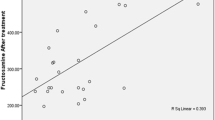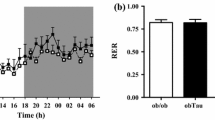Abstract
Carnosine, a naturally occurring dipeptide present in an omnivorous diet, has been shown to ameliorate the development of metabolic syndrome, type-2 diabetes (T2D) and early- and advanced-stage diabetic nephropathy in different rodent models. Anserine, its methylated analogue, is more bio-available in humans upon supplementation without affecting its functionality. In this work, we investigated the effect of oral supplementation with anserine or carnosine on circulating and tissue anserine and carnosine levels and on the development of T2D and diabetic nephropathy in BTBR ob/ob mice. BTBR ob/ob mice were either supplemented with carnosine or anserine in drinking water (4 mM) for 18 weeks and compared with non-supplemented BTBR ob/ob and wild-type (WT) mice. Circulating and kidney, but not muscle, carnosine, and anserine levels were enhanced by supplementation with the respective dipeptides in ob/ob mice compared to non-treated ob/ob mice. The evolution of fasting blood glucose, insulin, fructosamine, triglycerides, and cholesterol was not affected by the supplementation regimens. The albumin/creatine ratio, glomerular hypertrophy, and mesangial matrix expansion were aggravated in ob/ob vs. WT mice, but not alleviated by supplementation. To conclude, long-term supplementation with anserine elevates circulating and kidney anserine levels in diabetic mice. However, anserine supplementation was not able to attenuate the development of T2D or diabetic nephropathy in BTBR ob/ob mice. Further research will have to elucidate whether anserine can attenuate milder forms of T2D or metabolic syndrome.




Similar content being viewed by others
Availability of data and material
The datasets generated during and/or analysed during the current study are available from the corresponding author on reasonable request.
Code availability
Not applicable.
References
Albrecht T, Schilperoort M, Zhang S et al (2017) Carnosine attenuates the development of both type 2 diabetes and diabetic nephropathy in BTBR ob/ob mice. Sci Rep 7:44492. https://doi.org/10.1038/srep44492
Aldini G, Orioli M, Rossoni G et al (2011) The carbonyl scavenger carnosine ameliorates dyslipidaemia and renal function in Zucker obese rats. J Cell Mol Med 15:1339–1354. https://doi.org/10.1111/j.1582-4934.2010.01101.x
Anderson EJ, Vistoli G, Katunga LA et al (2018) A carnosine analog mitigates metabolic disorders of obesity by reducing carbonyl stress. J Clin Investig 128:5280–5293. https://doi.org/10.1172/JCI94307
Aune D, Norat T, Leitzmann M et al (2015) Physical activity and the risk of type 2 diabetes: a systematic review and dose-response meta-analysis. Eur J Epidemiol 30:529–542. https://doi.org/10.1007/s10654-015-0056-z
Barca A, Gatti F, Spagnolo D et al (2018) Responsiveness of carnosine homeostasis genes in the pancreas and brain of streptozotocin-treated mice exposed to dietary carnosine. Int J Mol Sci 19:1–11
Bergijk EC, Munaut C, Baelde JJ et al (1992) A histologic study of the extracellular matrix during the development of glomerulosclerosis in murine chronic graft-versus-host disease. Am J Pathol 140:1147–1156
Boldyrev AA, Aldini G, Derave W (2013) Physiology and pathophysiology of carnosine. Physiol Rev 93:1803–1845. https://doi.org/10.1152/physrev.00039.2012
Cuparencu C, Rinnan Å, Silvestre MP et al (2020) The anserine to carnosine ratio : an excellent discriminator between white and red meats consumed by free-living overweight participants of the PREVIEW study. Eur J Nutr. https://doi.org/10.1007/s00394-020-02230-3
de Paepe E, van Meulebroek L, Rombouts C et al (2018) A validated multi-matrix platform for metabolomic fingerprinting of human urine, feces and plasma using ultra-high performance liquid-chromatography coupled to hybrid orbitrap high-resolution mass spectrometry. Anal Chim Acta 1033:108–118. https://doi.org/10.1016/j.aca.2018.06.065
Everaert I, Taes Y, de Heer E et al (2012) Low plasma carnosinase activity promotes carnosinemia after carnosine ingestion in humans. Am J Physiol Ren Physiol 302:F1537–F1544. https://doi.org/10.1152/ajprenal.00084.2012
Everaert I, Baron G, Barbaresi S et al (2019) Development and validation of a sensitive LC–MS/MS assay for the quantification of anserine in human plasma and urine and its application to pharmacokinetic study. Amino Acids 51:103–114. https://doi.org/10.1007/s00726-018-2663-y
Everaert I, He J, Hanssens M et al (2020) Carnosinase-1 overexpression, but not aerobic exercise training, affects the development of diabetic nephropathy in BTBR ob/ob mice. Am J Physiol Ren Physiol 318:F1030–F1040. https://doi.org/10.1152/ajprenal.00329.2019
Everaert I, Baron G, Barbaresi S et al (2018) Development and validation of a sensitive LC–MS/MS assay for the quantification of anserine in human plasma and urine and its application to pharmacokinetic study. Amino Acids 51:103–114
Geissler S, Zwarg M, Knütter I et al (2010) The bioactive dipeptide anserine is transported by human proton-coupled peptide transporters. FEBS J 277:790–795. https://doi.org/10.1111/j.1742-4658.2009.07528.x
Ghosal S, Nunley A, Mahbod P et al (2015) Mouse handling limits the impact of stress on metabolic endpoints. Physiol Behav 150:31–37. https://doi.org/10.1016/j.physbeh.2015.06.021
Hudkins KL, Pichaiwong W, Wietecha T et al (2010) BTBR Ob/Ob mutant mice model progressive diabetic nephropathy. J Am Soc Nephrol 21:1533–1542. https://doi.org/10.1681/ASN.2009121290
Iacobini C, Menini S, Blasetti Fantauzzi C et al (2018) FL-926-16, a novel bioavailable carnosinase-resistant carnosine derivative, prevents onset and stops progression of diabetic nephropathy in db/db mice. Br J Pharmacol 175:53–66. https://doi.org/10.1111/bph.14070
Jannasch F, Kröger J, Schulze M (2017) Dietary patterns and type 2 diabetes: a systematic literature review and meta-analysis of prospective studies. J Nutr Nutr Epidemiol 147:1174–1182. https://doi.org/10.3945/jn.116.242552.as
Jappar D, Hu Y, Keep RF, Smith DE (2009) Transport mechanisms of carnosine in SKPT cells: contribution of apical and basolateral membrane transporters. Pharm Res 26:172–181. https://doi.org/10.1007/s11095-008-9726-9
Kamal MA, Jiang H, Hu Y et al (2009) Influence of genetic knockout of Pept2 on the in vivo disposition of endogenous and exogenous carnosine in wild-type and Pept2 null mice. Am J Physiol Regul Integr Comp Physiol 296:R986–R991. https://doi.org/10.1152/ajpregu.90744.2008
Kubomura D, Matahira Y, Masui A, Matsuda H (2009) Intestinal absorption and blood clearance of l-histidine-related compounds after ingestion of anserine in humans and comparison to anserine-containing diets. J Agric Food Chem 57:1781–1785. https://doi.org/10.1021/jf8030875
Kubomura D, Matahira Y, Nagai K, Niijima A (2010) Effect of anserine ingestion on hyperglycemia and the autonomic nerves in rats and humans. Nutr Neurosci 13:183–188. https://doi.org/10.1179/147683010X12611460764363
Menini S, Iacobini C, Ricci C et al (2015) Protection from diabetes-induced atherosclerosis and renal disease by d-carnosine-octylester: effects of early vs late inhibition of advanced glycation end-products in Apoe-null mice. Diabetologia 58:845–853. https://doi.org/10.1007/s00125-014-3467-6
Mong MC, Chao CY, Yin MC (2011) Histidine and carnosine alleviated hepatic steatosis in mice consumed high saturated fat diet. Eur J Pharmacol 653:82–88. https://doi.org/10.1016/j.ejphar.2010.12.001
Peters V, Jansen EEW, Jakobs C et al (2011) Anserine inhibits carnosine degradation but in human serum carnosinase (CN1) is not correlated with histidine dipeptide concentration. Clin Chim Acta 412:263–267. https://doi.org/10.1016/j.cca.2010.10.016
Peters V, Schmitt CP, Zschocke J et al (2012) Carnosine treatment largely prevents alterations of renal carnosine metabolism in diabetic mice. Amino Acids 42:2411–2416. https://doi.org/10.1007/s00726-011-1046-4
Peters V, Riedl E, Braunagel M et al (2014) Carnosine treatment in combination with ACE inhibition in diabetic rats. Regul Pept 194–195:36–40. https://doi.org/10.1016/j.regpep.2014.09.005
Peters V, Calabrese V, Forsberg E et al (2018) Protective actions of anserine under diabetic conditions. Int J Mol Sci 19:2751. https://doi.org/10.3390/ijms19092751
Pfister F, Riedl E, Wang Q et al (2011) Oral carnosine supplementation prevents vascular damage in experimental diabetic retinopathy. Cell Physiol Biochem 28:125–136. https://doi.org/10.1159/000331721
Qiu J, Albrecht T, Zhang S et al (2020) Human carnosinase 1 overexpression aggravates diabetes and renal impairment in BTBROb/Ob mice. J Mol Med. https://doi.org/10.1007/s00109-020-01957-0
Rezzani R, Favero G, Ferroni M et al (2019) A carnosine analog with therapeutic potentials in the treatment of disorders related to oxidative stress. PLoS One 14:1–18. https://doi.org/10.1371/journal.pone.0215170
Riedl E, Pfister F, Braunagel M et al (2011) Carnosine prevents apoptosis of glomerular cells and podocyte loss in STZ diabetic rats. Cell Physiol Biochem 28:279–288. https://doi.org/10.1159/000331740
Sauerhoefer S, Yuan G, Braun GS et al (2007) l-Carnosine, a substrate of carnosinase-1, influences glucose metabolism. Diabetes 56:2425–2432. https://doi.org/10.2337/db07-0177
Stegen S, Stegen B, Aldini G et al (2015) Plasma carnosine, but not muscle carnosine, attenuates high-fat diet-induced metabolic stress. Appl Physiol Nutr Metab 40:868–876. https://doi.org/10.1139/apnm-2015-0042
Sutter AG, Palanisamy AP, Kurtz N et al (2013) Efficient method of genotyping Ob/Ob mice using high resolution melting analysis. PLoS One 8:8–11. https://doi.org/10.1371/journal.pone.0078840
Tabata H, Kitamura T, Nagamatsu N (1998) Comparison of effects of restraint, cage transportation, anaesthesia and repeated bleeding on plasma glucose levels between mice and rats. Lab Anim 32:143–148. https://doi.org/10.1258/002367798780599983
Weigand T, Colbatzky F, Pfeffer T et al (2020) A global cndp1-knock-out selectively increases renal carnosine and anserine concentrations in an age-and gender-specific manner in mice. Int J Mol Sci 21:1–21. https://doi.org/10.3390/ijms21144887
Yay A, Akkuş D, Yapislar H et al (2014) Antioxidant effect of carnosine treatment on renal oxidative stress in streptozotocin-induced diabetic rats. Biotech Histochem 89:552–557. https://doi.org/10.3109/10520295.2014.913811
Acknowledgements
The (technical) assistance of the animal caretakers, Clinical lab of University Hospital UZ Ghent and Anneke Volkaert is greatly acknowledged. The lab of Chemical Analysis research group is part of the Ghent University expertise centre MSsmall. We thank Flamma for providing the carnosine and anserine.
Funding
This study was financially supported by grants from Special Research Fund of Ghent University. IE is a recipient of a post-doctoral scholarship by the Research Foundation—Flanders (FWO).
Author information
Authors and Affiliations
Contributions
IE and WD designed the study. IE, TVDS, JS, MH, CVA, and HB performed research. IE, TVDS, JS, CVA and HB analyzed the data. IE, TVDS, JS, MH, HB, LV, and WD wrote the paper.
Corresponding author
Ethics declarations
Conflict of interest
The authors have no conflicts of interest to declare that are relevant to the content of this article.
Ethical approval
The experimental protocol was approved by the Ethics Committee for Animal Research at Ghent University and followed the Principles of Laboratory Animal Care.
Additional information
Handling editor: G. J. Peters.
Publisher's Note
Springer Nature remains neutral with regard to jurisdictional claims in published maps and institutional affiliations.
Supplementary Information
Below is the link to the electronic supplementary material.
Rights and permissions
About this article
Cite this article
Everaert, I., Van der Stede, T., Stautemas, J. et al. Oral anserine supplementation does not attenuate type-2 diabetes or diabetic nephropathy in BTBR ob/ob mice. Amino Acids 53, 1269–1277 (2021). https://doi.org/10.1007/s00726-021-03033-4
Received:
Accepted:
Published:
Issue Date:
DOI: https://doi.org/10.1007/s00726-021-03033-4




